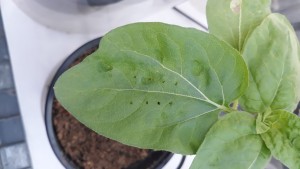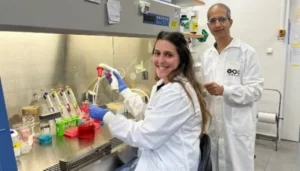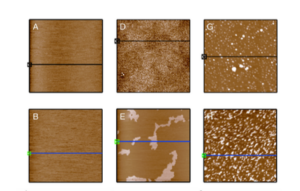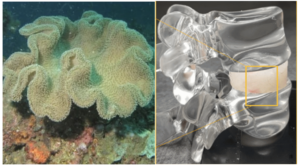Université de Tel Aviv (Israël) : des plantes pour dépolluer les sols et appel à la coopération entre scientifiques et élus

[:fr]
Zavit. Une nouvelle étude israélienne a présenté un moyen efficace et écologique de nettoyer les sols contaminés par des métaux lourds, qui implique quelques astuces. Quiconque a vu le film de 1986, Little Shop of Horrors, se souvient d’Audrey II, la plante carnivore parlante qui adorait le sang humain. Alors que le film prend des libertés créatives avec les capacités de la plante, le personnage d’Audrey II s’inspire de la flore naturelle comme les pièges à mouches de Vénus (Dionaea muscipula) et les feuilles des plantes Nepenthaceae, Sarraceniaceae et Cephalotaceae qui dévorent les insectes à la recherche de nectar. On peut même rapprocher le discours d’Audrey II (bien qu’exagéré pour un effet dramatique) d’un phénomène naturel dans lequel certaines plantes sont capables de communiquer entre elles via une signalisation chimique.
Mais la liste des capacités non conventionnelles présentées par les plantes ne s’arrête pas là. Présentée à la 49ème conférence annuelle pour la science et l’environnement en juillet dernier, une nouvelle étude israélienne a découvert un autre service écosystémique surprenant que certaines plantes peuvent fournir : la capacité d’absorber et d’éliminer une quantité inhabituellement importante de métaux polluants comme le cadmium, un métal commun composant dans les engrais, provenant de sols contaminés. Et curieusement, les chercheurs ont découvert que ces plantes peuvent purifier les sols encore plus rapidement si les plantes sont amenées à penser qu’elles sont attaquées ou mangées.
Souillé par les métaux

Tant en Israël que dans le monde, la contamination des sols d’origine humaine est devenue une conséquence bien trop courante de l’activité industrielle et infrastructurelle moderne. En raison du raffinage du carburant, de l’utilisation de pesticides et d’engrais agricoles, des activités militaires et de la présence d’égouts municipaux et de décharges, les métaux lourds finissent par s’infiltrer dans les eaux souterraines et les couches de sol. Cela toxique non seulement l’environnement, mais nous expose également à un risque d’exposition directe via l’eau potable ou la consommation de produits agricoles. « Il y a quelques années, alors que je visitais l’Inde, j’ai vu de mes propres yeux la pollution de l’environnement et des sources d’eau», explique Eyal Grossman, étudiant diplômé et chercheur principal de l’École des sciences de l’environnement et de la Terre de l’Université de Tel Aviv.
Après avoir vu l’horreur que cela représentait et les difficultés que cela causait, il a compris à quel point il était important de traiter la pollution. « Je rêvais de traiter la pollution métallique par des moyens naturels », ajoute-t-il. Alors, combien de sol est contaminé par les métaux lourds ? Avec l’essor de l’industrie, de l’agriculture et de l’urbanisation, il est difficile d’y attribuer une valeur exacte et définitive, car des rapports sur la pollution des sols sont activement déposés. Plus de 10 millions de sites de pollution des sols ont été signalés dans le monde à ce jour, et plus de la moitié de ces sites sont contaminés par des métaux lourds et/ou des métalloïdes. Selon Eyal Grossman, « environ 28% du sol du continent européen est actuellement contaminé par un ou plusieurs métaux lourds à une concentration supérieure aux valeurs seuil fixées par le ministère finlandais de la Protection de l’environnement (MoEP)« .
Cela semble être un dilemme environnemental commun qui s’étend à tous les pays semi-hautement industrialisés, y compris Israël. À la suite d’une enquête sur la pollution des sols menée en 2014, le ministère de l’Environnement d’Israël a identifié 23100 zones localisées dans tout Israël qui sont ou ont le potentiel d’être contaminées par des opérations actuellement ou autrefois actives. L’aquifère côtier d’Israël en est un excellent exemple.
Entre les stations-service, les usines industrielles, les bases militaires et les décharges, la zone de la plaine côtière est devenue gravement polluée par des métaux lourds au fil des ans ; à tel point qu’en 2018, 8% de l’eau potable disponible dans la plaine côtière avait été contaminée et que près de 200 sites de forage d’eau souterraine (environ un quart des sites de forage d’Israël) avaient été fermés. Et réparer la terre n’est pas une mince affaire et cela coûte cher. Entre l’excavation, le transport et le traitement des sols pollués, le coût de l’assainissement des terres en Israël s’élève à lui seul à environ 9,8 Mds de shekels, un montant dont les pollueurs paient la majeure partie.
Ce fardeau financier se répète dans tous les pays industrialisés, entraînant un impact économique mondial cumulé dépassant les 10Md$ par an. « Le problème avec les métaux polluants du sol, c’est qu’ils ne se décomposent pas », explique Eyal Grossman. Sans traitement approprié des sols et traitement de la pollution à sa source, la concentration de métaux lourds dans le sol restera et augmentera probablement. Cependant, les métaux ne restent pas au même endroit dans le sol, c’est là que le problème commence : les métaux sont absorbés par les plantes et remontent inévitablement la chaîne alimentaire.
Dans les zones agricoles, par exemple, les métaux dangereux provenant des engrais, des pesticides, des eaux usées irriguées, des biosolides et du fumier peuvent s’accumuler dans les cultures et les animaux de ferme avant d’atteindre nos assiettes. Autrement dit, si les métaux évitent d’abord de s’infiltrer dans nos eaux souterraines pour contaminer plus tard l’eau potable dans nos verres. Quoi qu’il en soit, l’environnement en pâtit et la santé publique pourrait être gravement menacée, en particulier en ce qui concerne le plomb, l’arsenic ou le cadmium, tous des polluants métalliques courants particulièrement toxiques.

Définie par le CIRC (Centre International de Recherche sur le Cancer) comme un cancérogène certain pour l’homme, l’exposition au cadmium en particulier peut entraîner des complications de santé telles que des lésions rénales et des malformations osseuses. Sur le plan environnemental, des niveaux élevés de cadmium dans le sassafras (Sassafras tzumu), par exemple, altèrent les capacités photosynthétiques de l’arbre. Pour les besoins de la nouvelle étude israélienne, les chercheurs ont bricolé la phytoremédiation, une stratégie à base de plantes destinée à réduire la biodisponibilité des polluants dans le sol à l’aide de certaines plantes qualifiées d’hyperaccumulatrices : des plantes des centaines ou des milliers de fois plus efficaces pour stocker certaines métaux et métalloïdes dans leurs tissus organiques que ce qui est considéré comme normal pour la plupart des plantes.
Pourquoi ces plantes font-elles ça ?
« L’hypothèse la plus courante aujourd’hui est que les hyperaccumulateurs absorbent les métaux dans leur corps et les transfèrent aux feuilles pour éloigner les parasites qui évitent les métaux« , explique Eyal Grossman. À ce jour, environ 721 hyperaccumulateurs ont été identifiés, parmi lesquels des plantes communément connues comme le tournesol, le maïs et le colza (dont l’huile de canola est extraite). « Habituellement, les sols contaminés sont enlevés avec des bulldozers et envoyés dans une installation de traitement, ce qui coûte beaucoup d’argent, ou ils sont simplement enterrés ailleurs, auquel cas la pollution est simplement transportée et le problème reste sans solution« , explique Grossman.
Mais avec les centaines de plantes hyperaccumulatrices identifiées et le processus bien compris de phytoremédiation, nous pouvons plutôt nous asseoir et laisser la nature « faire son travail ». Sur la base des contaminants métalliques suspectés ou connus incrustés dans un site particulier, certains hyperaccumulateurs pourraient être plantés dans cette zone, et ces plantes pourraient idéalement absorber les métaux dans leurs tissus et ainsi améliorer la fertilité du sol au fil du temps. Ensuite, après la récolte des plantes, les métaux seraient retirés de l’environnement sans encourir de dépenses supplémentaires ni endommager la terre elle-même. De plus, ces plantes remplies de métal pourraient devenir une matière première importante plutôt que de se retrouver sous forme de déchets organiques mis au rebut et d’aller à l’encontre de leur objectif.
« Souvent, le biocarburant peut être fabriqué à partir des plantes contaminées », explique Eyal Grossman. Cependant, à ce jour, la méthode d’élimination des polluants n’a pratiquement pas été utilisée en dehors des limites des laboratoires et des serres. Eyal Grossman souligne que la principale raison pour laquelle cette méthode est négligée est que le taux de croissance des plantes est relativement lent. Cela signifie que cela peut prendre plusieurs années jusqu’à ce que tous les polluants soient complètement éradiqués du sol. Du coup, la méthode n’est souvent pas perçue comme économiquement viable, en particulier en Israël où la restauration rapide des terres est généralement entreprise en raison de la pression du développement immobilier et des infrastructures, qui ont tous deux tendance à exiger des solutions immédiates.
Absorber plus rapidement
En raison du temps plus court que souhaité pour faire revivre une zone de terre via la phytoremédiation, les chercheurs se sont demandé ce qui pourrait éventuellement accélérer le processus pour peut-être rendre la stratégie plus économiquement viable. La solution que les chercheurs ont découverte était inhabituelle : des dommages à la plante. Les chercheurs ont injecté du cadmium dans le sol en pot de 80 plants de tournesol communs, puis ont fait « penser » à un groupe de plants qu’ils étaient attaqués par des insectes. Pour ce faire, ils ont fait de petites perforations dans les feuilles avec un cure-dent et les ont aspergées d’acide jasmonique, une hormone végétale.
« Il est produit par presque toutes les plantes lorsque les parasites les attaquent, et il déclenche les mécanismes de défense de la plante« , explique Eyal Grossman. Les résultats de l’étude ont été plus qu’encourageants. La quantité de cadmium absorbée par le groupe de tournesols pulvérisés à l’acide et perforés était 40 % plus élevée que celle du groupe de tournesols qui n’avait reçu aucun traitement spécial. Selon Eyal Grossman, cela équivaut à réduire de près de moitié le temps nécessaire à une phytoremédiation efficace. De plus, il est à noter que les tournesols ayant reçu le traitement par pulvérisation et perforation n’ont subi aucun dommage inhibiteur.
Au lieu de cela, ce groupe de tournesols traités a poussé de manière identique au groupe non traité. « Nous travaillons déjà sur la prochaine expérience, dans laquelle nous examinerons si le cadmium est également stocké dans le corps de la plante, et pas seulement dans ses feuilles. C’est-à-dire si la plante absorbe encore plus de cadmium que nous ne le pensons », explique Eyal Grossman. « J’appelle les municipalités et les conseils locaux qui possèdent des terres contaminées qui seront bientôt abandonnées à coopérer avec le monde universitaire », déclare Eyal Grossman. « Il est dommage que les sites contaminés continuent de nuire à la santé des terres et du public, alors que vous appliquez plutôt des méthodes et des technologies de réhabilitation vertes viables, qui purifieront les terres pour le bénéfice de tous. »
Article de Omer Yerushalmi et Max Kaplan-Zantopp pour ZAVIT 13 oct. 2021
Cet article a également été publié dans NoCamels le 11 oct. 2021
[:en]
Zavit. Anyone who has seen the classic 1986 film, Little Shop of Horrors, remembers Audrey II, the talking carnivorous plant with an appetite for human blood. While the film takes creative liberties with the plant’s capabilities, the character of Audrey II is inspired by naturally occurring flora like Venus flytraps (Dionaea muscipula) and pitcher plants from the Nepenthaceae, Sarraceniaceae, and Cephalotaceae families that devour nectar-seeking insects. A parallel can even be drawn from Audrey II’s speech (albeit exaggerated for dramatic effect) to a natural phenomenon in which some plants are able to communicate with each other via chemical signaling.
But the list of unconventional abilities exhibited by plants does not end here. Presented at the 49th Annual Conference for Science and the Environment this past July, a new Israeli study has uncovered yet another surprising ecosystem service certain plants can perform: the ability to absorb and remove an unusually large amount of pollutive metals like cadmium, a common metal component in fertilizers, from contaminated soils. And oddly enough, the researchers found that these plants can purify soils even faster if the plants are tricked into thinking they are being attacked or eaten.
Soiled by Metals
Both in Israel and around the world, human-caused soil contamination has become an all-too-common consequence of modern industrial and infrastructural activity. As a result of fuel refining, the use of agricultural pesticides and fertilizers, military activities, and the presence of municipal sewage and landfills, heavy metals wind up seeping into groundwater and layers of soil. This not only toxifies the environment but also puts us at risk of direct exposure via drinking water or consuming farmed produce.

“A few years ago while I was touring India, I actually saw the pollution of the environment and water sources with my own eyes,” says Eyal Grossman, graduate student and lead researcher from Tel Aviv University’s School of Environmental and Earth Sciences. After seeing the eyesore that it was and the hardship it caused, he understood just how important treating pollution is. “I had a dream to treat metal pollution by natural means,” he adds.
So, how much soil is contaminated by heavy metals? With industry, agriculture, and urbanization all on the rise, it’s difficult to put an exact, definite value on it because reports of soil pollution are being actively filed. In fact, there are more than 10 million sites of soil pollution reported around the world so far, and more than half of those sites are contaminated with heavy metals and/or metalloids. According to Grossman, an estimated 28% of the European continent’s soil is currently contaminated with one or more heavy metals in a concentration above the threshold values set by Finland’s Ministry of Environmental Protection (MoEP).
This seems to be a common environmental dilemma that extends to all semi-highly industrialized countries, including Israel. Following a land pollution survey conducted in 2014, Israel’s MoEP identified 23,100 localized areas throughout Israel that are or have the potential to become contaminated from currently or formerly active operations.
Israel’s coastal aquifer is a prime example of this. Between the gas stations, industrial plants, military bases, and landfills, the coastal plain area has become severely polluted with heavy metals over the years; so much so that by 2018, 8% of the available drinking water in the coastal plain had been contaminated, and close to 200 groundwater drilling sites (about a quarter of Israel’s drilling sites) had been shut down.
And mending the land is no small task; nor is it cheap. Between excavating, transporting, and treating the polluted soils, the cost to remediate the land in Israel alone totals approximately NIS 9.8 billion, an amount that the polluters themselves pay the vast majority. Versions of this financial burden play out in every industrialized country, incurring a cumulative worldwide economic impact surpassing $10 billion per year.
“The problem with soil-polluting metals is that they do not decompose,” says Eyal Grossman. Without proper soil treatment and treating pollution at its source, the concentration of heavy metals in the soil will remain and likely increase. However, the metals do not stay in one place within the soil, which is where the problem starts: the metals are taken up through plants and inevitably move up the food chain. In agricultural areas, for instance, hazardous metals originating from fertilizers, pesticides, irrigated wastewater, biosolids, and manure can accumulate in crops and farm animals before they make it to our plates. That is, if the metals somehow first avoid seeping into our groundwater to later contaminate the drinking water in our glasses. Either way, the environment suffers, and public health could be put in serious jeopardy, especially when it comes to lead, arsenic, or cadmium—all common metal pollutants that are particularly toxic.

Let Nature Do Its Thing
Defined by the IARC (International Agency for Research on Cancer) as a definite carcinogen in humans, exposure to cadmium in particular can lead to health complications such as kidney damage and bone malformations. In terms of the environment, high levels of cadmium in sassafras (Sassafras tzumu), for example, impair the tree’s photosynthetic capabilities.
For the purposes of the new Israeli study, the researchers tinkered with phytoremediation, a plant-based strategy intended for reducing the bioavailability of pollutants in soil using certain plants that qualify as hyperaccumulators: plants that are hundreds or thousands of times more effective at storing particular metals and metalloids in their organic tissues than what is considered normal for most plants. Why do these plants do this?
“The most common hypothesis today is that hyperaccumulators absorb the metals into their bodies and transfer them to the leaves to keep out pests that avoid metals,” Grossman says.
To date, about 721 hyperaccumulators have been identified which include commonly known plants like the sunflower, corn, and rapeseed (from which canola oil is extracted).
“Usually, contaminated soil is removed with bulldozers and sent to a treatment facility, which costs a lot of money, or it’s simply buried elsewhere, in which case the pollution is simply transported, and the problem remains unsolved,” Grossman explains.
But with the hundreds of identified hyperaccumulator plants and the well understood process of phytoremediation, we can instead sit back and let nature “do its thing”. Based on the suspected or known metallic contaminants embedded in a particular site, certain hyperaccumulators could be planted in that area, and those plants could ideally absorb the metals into their tissues and thus improve soil fertility over time. Then, after harvesting the plants, the metals would be removed from the environment without incurring additional expenses or damaging the land itself.
What’s more is that these metal-filled plants could go on to become an important raw material rather than winding up as discarded organic waste and defeating their purpose entirely. “Many times, biofuel can be made from the contaminated plants,” says Grossman.
However, to date, the method of pollutant removal has hardly been used outside the confines of laboratories and greenhouses. Grossman points out in his study is that the main reason why this method is overlooked is because the rate of the plants’ growth is relatively slow. This means it can take several years until all the pollutants are completely eradicated from the soil, so the method is not often perceived as economically viable, especially in Israel where rapid land restoration is usually undertaken due to the pressure outpouring from real estate and infrastructure development, both of which tend to require immediate solutions.
Absorb Faster
Because of the less-than-desired time it takes to revive an area of land via phytoremediation, the researchers wondered what could possibly speed up the process to perhaps make the strategy more economically viable. The solution the researchers discovered was unusual: damage to the plant.
The researchers injected cadmium into the potted soil of 80 common sunflower plants and then caused one group of plants to “think” they were being attacked by insects. To do this, they made small perforations in the leaves with a toothpick and sprayed them with Jasmonic acid, a plant hormone. “It is produced by almost all plants when pests attack them, and it triggers the plant’s defense mechanisms,” Grossman explains.
The results of the study were more than encouraging. The amount of cadmium absorbed by the acid-sprayed and perforated group of sunflowers was 40% higher compared to the sunflower group that did not receive any special treatment. According to Grossman, this is equivalent to shortening the time required for effective phytoremediation by almost half. Plus, it should be noted that the sunflowers that received the spraying and perforation treatment did not suffer any inhibitive damage. Instead that group of treated sunflowers grew identically to the untreated group.
“We are already working on the next experiment, in which we will examine whether cadmium is also stored in the plant’s body, and not just its leaves. That is, whether the plant absorbs even more cadmium than we think,” Grossman explains.
“I call on municipalities and local councils that own contaminated land that is soon to be abandoned to cooperate with academia,” Grossman states. “It is a pity that contaminated sites will go on to harm the health of the land and the public, when you instead apply viable green rehabilitation methods and technologies, which will purify land for the benefit of us all.”
This ZAVIT Article was also published in NoCamels on 11 Oct. 2021
[:]







